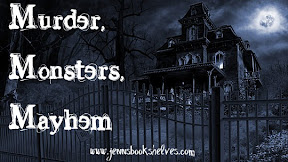Today I’m excited to present you all with a guest post from one of my favorite horror authors, Graham Masterton. Following is a bio taken from his web site:
Graham Masterton’s debut as a horror author began with The Manitou in 1976, a chilling tale of a Native American medicine man reborn in the present day to exact his revenge on the white man. It became an instant bestseller and was filmed with Tony Curtis, Susan Strasberg, Burgess Meredith, Michael Ansara, Stella Stevens and Ann Sothern.
Since then Graham has published more than 35 horror novels, including Charnel House, which was awarded a Special Edgar by Mystery Writers of America; Mirror, which was awarded a Silver Medal by West Coast Review of Books; and Family Portrait, an update of Oscar Wildeis tale, The Picture of Dorian Gray, which was the only non-French winner of the prestigious Prix Julia Verlanger in France.
Three of Graham’s stories were filmed for TV in Tony Scottis horror series The Hunger, and ‘The Secret Shih-Tan’, starring Jason Scott Lee, was shortlisted for a Bram Stoker Award by the Horror Writers Association. Another short story, ‘Underbed’, about a boy finding a mysterious world underneath his blankets, was voted best short story by Horror Critics Guild.
Graham’s latest horror novels to be published in the United States are Spirit (Leisure,December, 2001); Trauma, (Signet, January, 2002) and The Chosen Child (Tor, January, 2002). Motion picture rights in Trauma have been optioned by Jonathan Mostow, who directed U-571. The Chosen Child, set in the sewers of Warsaw, was named Best Horror Novel of the Year by Science Fiction Chronicle and highly praised in Publisheris Weekly.
Altogether Graham has written more than a hundred novels ranging from thrillers (The Sweetman Curve, Ikon) to disaster novels (Plague, Famine) to historical sagas (Rich and Maiden Voyage – both appeared in the New York Times bestseller list). He has published four collections of short stories, Fortnight of Fear, Flights of Fear, Faces of Fear and Feelings of Fear.
He has also written horror novels for children (House of Bones, Hair-Raiser) and has just finished the fifth volume in a very popular series for young adults, Rook, based on the adventures of an idiosyncratic remedial English teacher in a Los Angeles community college who has the facility to see ghosts.
Graham’s guest post today discusses why he decided to write horror. Without further ado..

WHY HORROR?
Believe it or not, I have never thought of myself as a horror writer. Horror to me is just a category which book retailers put your books into because they happen to have violent or supernatural content, or both. I have never made any distinction between horror fiction and any other kind of fiction. Fiction should always challenge what you believe in, and make you think hard about what it is to be a human being.
I started writing fiction at a very early age, inspired by Jules Verne and Edgar Allan Poe in particular. I would write three or four page stories and read them out to my friends during lunchbreak at school. Some of them were horror stories, but I also wrote science fiction, and war stories — even some humorous stories with a character like a modern-day Mr. Pickwick.
Some of the horror stories, though, made a lasting impression on my friends. Twenty-five years later, a schoolfriend told me that even though he was now a city manager, he still had nightmares about a man with no head who used to walk about the house singing Tiptoe Through The Tulips.
What almost all of my stories shared, though, even at that age, was my feeling that fiction should take readers right to the very edge of human experience. Reality is strange, and exhilarating, and tragic. Sometimes reality is well beyond our understanding. But I always believed that fiction should take us even further, right to the very boundaries of our humanity.
When I was 13, I wrote a 400-page horror novel in which the sole purpose of a mysterious sect of vampires was self-destruction. At 15, I discovered the Beat writers like Jack Kerouac and Allen Ginsberg and William Burroughs who were taking both the style and the content of their writing to an extreme. William Burroughs wrote a novel called The Naked Lunch which caused an uproar when it was published in 1962 because of its political and homosexual content and its open discussion of drugs.
William was living in Tangier at the time but I wrote to him and we kept up a regular correspondence until he came to live in London in 1965. By then I was deputy editor of a new men’s magazine called Mayfair. William wrote for Mayfair regularly and we spent many evenings in his apartment on Duke Street discussing revolutionary writing techniques. With William’s encouragement and involvement I wrote a novel myself, Rules of Duel, the manuscript of which I recently discovered after forty years and which was published last year by my good friend David Howe from Telos Books.
The writing that William and I did together was difficult, often obscure, and pushed convention and accepted taste right to the very limit, and beyond. You probably won’t be able to grasp much of what Rules of Duel is all about. But William had some very good lessons, not just for a horror writer but for any kind of writer who wants to take writing to the very edge.
The writer should not appear in his own work. He should be El Hombre Invisible, the invisible man. Learn how to construct sentences so balanced and rhythmical that your readers are scarcely aware they are reading at all. This takes painstaking practice, especially with dialog, and a complete understanding of the mechanics of grammar. You need to be able to take your work apart and put it together again like a motor mechanic.
When you’re writing, don’t look at the page in front of you (or the screen, these days.) Be there. Feel the wind on your back and hear the noises all around you. Take your characters by the hand so that you can physically feel them.
And never be scared to say anything. Ever.
Several times, I have purposely taken my work beyond the boundaries of accepted taste. I suppose it started with my novel Ritual, which was a jolly story about gourmet cannibals.
The Celestines were a religious sect who believed that they would eventually get to see God by devouring their own bodies. They kidnap the son of our hero, who rather appropriately happens to be a restaurant critic, and in his attempt to rescue the boy, the critic joins the sect. To be accepted by them, though, he has to show that he is prepared to consume part of himself. He cuts off his own finger, fries it and eats it.
Other stories that have gone right to the edge and over include the notorious Eric the Pie, which was the cover story for the first issue of Frighteners magazine, and was considered to be so disgusting by WH Smith that they banned it from their retail outlets, leading to the magazine’s very sad demise after only two issues. You can read Eric in the fiction section of my website www.grahammasterton.co.uk and make up your own mind.
Eric recently reappeared in a chapbook called Tales Too Extreme For Cemetery Dance. Cemetery Dance also published a chapbook called Sepsis which I deliberately wrote to go right to the limit of what readers could swallow. A story called Epiphany was sadly but understandably dropped by my publisher from my recent collection of short stories Festival of Fear (Severn House) because of its sexual content.
A favourite device of mine is to make ancient and mythical threats re-appear in the modern-day world so that ordinary people like you and me have to find a way to deal with them. The reason why legendary beings can be so frightening is because they were devised in days when people had no understanding of disease, or natural disasters, and so they attributed them to demons and ghosts and vengeful gods. Why did your cattle die? Because creatures came in the night and sucked the blood out of them. What caused cot death? Witches who crept into your house when you were asleep and stole your baby’s soul.
But again, I don’t consider this to be “horror” fiction. It’s just stories as stories have always been told. Stories to make you think who you are. Stories to help you to come to terms with your mortality. All of us who are alive at the moment are like a city, with its millions of lights sparkling in the night. One by one, though, the lights are extinguished, and then there is nothing but darkness. There lies the horror.
Stay tuned! Tomorrow I will review on of my favorite Masterton novels, The House That Jack Built.







2 Responses to #Mx3 Guest Post: Why Horror by Graham Masterton